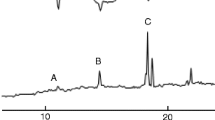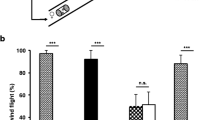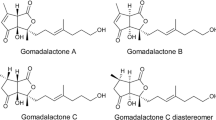Abstract
A laboratory investigation of theItoplectis conquisitor sex pheromone was initiated to elucidate the structure(s) of the active component(s) of the system. Functional group tests performed on crude virgin female extract classified the pheromone as unsaturated aldehyde(s) and/or ketone(s). Isolation of active fractions by gas-liquid chromatography (GLC) suggested the existence of a multicomponent pheromone system. Analysis by gas chromatography-mass spectrometry indicated the presence of saturated and unsaturated aldehydes including neral and geranial. When mixtures of neral and geranial were bioassayed independently and in combination with other active GLC fractions, they elicited male sexual activity of intensity comparable to that released by the GLC fraction (DEGS E) from which they were isolated. The authors conclude that neral and/or geranial are components of the sex pheromone system of this species.
Similar content being viewed by others
References
Beroza, M. 1970. Chemicals Controlling Insect Behavior. Academic Press, New York, 170 pp.
Beroza, M., andBierl, B. 1969. Ozone generator for microanalysis.Mikrochim. Acta (Wien) 4:720–721.
Butenandt, A., Beckmann, R., Stamm, D., andHecker, E. 1959. Über den Sexual-Lockstoff des SeidenspinnersBombyx mori, Reindarstellung und Konstitution.Z. Naturforsch. 14b:283–283.
Butler, C.G., andFairey, E.M. 1964. Pheromones of the honeybee: Biological studies of the mandibular gland secretion of the queen.J. Apicult. Res. 3:65–76.
Games, P.A., andKlare, G.R. 1967. Elementary Statistics. McGraw-Hill Book Company, New York, 564 pp.
Ikan, R., Gottlieb, R., Bergmann, E.D., andIshay, J. 1969. The pheromone of the queen of the oriental hornet,Vespa orientalis.J. Insect Physiol. 15:1709–1712.
Jewett, D.M., Matsumura, F., andCoppel, H.C. 1976. Sex pheromone specificity in the pine sawflies: Interchange of acid moieties in an ester.Science 192:51–53.
Kadin, S.B. 1966. Reduction of conjugated double bonds with sodium borohydride.J. Org. Chem. 31:620–622.
MacLeod, W.D., Jr., McFadden, W.H., andBuigues, N.M. 1966. Lemon oil analysis. II. Gas-liquid chromatography on a temperature programmed, long, open tubular column.J. Food Sci. 31(4):591–594.
March, J. 1968. Advanced Organic Chemistry: Reactions, Mechanisms, and Structure. McGraw-Hill Book Company, New York, 1098 pp.
Mayer, M.S., andMclaughlin, J.R. 1975. An annotated compendium of insect sex pheromones.Fl. Agric. Exp. Stn. Monogr. Ser. No. 6.
Nystrom, R.F., andBrown, W.G. 1947. Reduction of organic compounds by lithium aluminum hydride. II. Carboxylic acids.J. Am. Chem. Soc. 69:2548–2549.
Robacker, D.C., Weaver, K.M., andHendry, L.B. 1976. Sexual communication and associative learning in the parasitic waspItoplectis conquisitor (Say).J. Chem. Ecol. 2(1):39–48.
Author information
Authors and Affiliations
Rights and permissions
About this article
Cite this article
Robacker, D.C., Hendry, L.B. Neral and geranial: Components of the sex pheromone of the parasitic wasp,Itoplectis conquisitor . J Chem Ecol 3, 563–577 (1977). https://doi.org/10.1007/BF00989077
Received:
Revised:
Issue Date:
DOI: https://doi.org/10.1007/BF00989077




